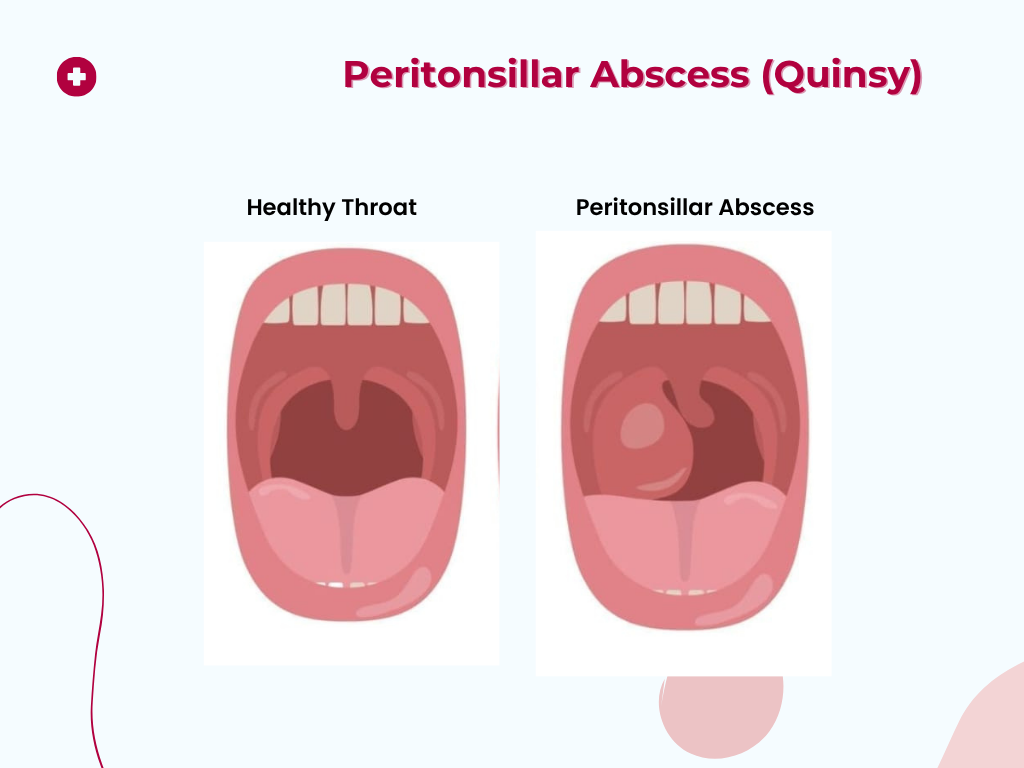
Overview
A peritonsillar abscess is a collection of pus in the peritonsillar space, typically resulting from the spread of infection from the tonsils.
Peritonsillar abscess (Quinsy) is a serious complication of tonsillitis, characterized by a collection of pus in the peritonsillar space. It requires prompt diagnosis and treatment to prevent potentially life-threatening complications.
The peritonsillar space is a potential space between the tonsillar capsule and the superior constrictor muscle of the pharynx.
Weber’s glands are small mucous glands located in the peritonsillar space. There are typically 2-4 Weber’s glands in the peritonsillar space, although the exact number can vary.
The Weber’s glands are thought to play a role in the development of peritonsillar abscesses, as they can become infected and contribute to the formation of abscesses in the peritonsillar space.
Epidemiology
Peritonsillar abscesses are more common in children and young adults, particularly those with a history of recurrent tonsillitis.
Pathophysiology
The development of a peritonsillar abscess typically involves the spread of bacteria from the tonsils to the peritonsillar space, leading to abscess formation.
Theories of Formation of Peritonsillar Abscess
Several theories have been proposed, including:
-
1. Direct spread:
Bacteria spread directly from the tonsils to the peritonsillar space.
-
2. Blockage of Weber's gland:
Blockage of Weber's gland may contribute to the development of peritonsillar abscesses.
Diagnosis
Symptoms and signs
Common symptoms and signs include:
1. Severe sore throat: Often unilateral and worsening over time.
2. Dysphagia: Difficulty swallowing due to pain and swelling.
3. Fever: Elevated body temperature.
4. Trismus: Limited mouth opening due to pain and swelling.
5. Uvular deviation: The uvula may be deviated away from the affected side.
Differential Diagnosis of Quinsy
Other conditions that may mimic Quinsy include:
-
1. Tonsillitis:
Inflammation of the tonsils without abscess formation.
-
2. Parapharyngeal abscess:
Abscess formation in the parapharyngeal space.
-
3. Retropharyngeal abscess:
Abscess formation in the retropharyngeal space.
Investigations
Diagnosis is typically made based on clinical examination and imaging studies, such as:
-
1. Computed Tomography (CT) scan:
May be used to confirm the presence of an abscess and assess its extent.
-
2. Ultrasound:
May be used to guide needle aspiration.
Complications
Untreated Quinsy can lead to serious complications, including:
-
1. Airway obstruction:
Swelling and abscess formation can compromise the airway.
-
2. Spread of infection:
Infection can spread to other areas of the head and neck.
-
3. Sepsis:
Bacteria can enter the bloodstream and cause sepsis.
Management of Quinsy
Treatment typically involves a combination of medical and surgical approaches.
Medical Management
-
1. Antibiotics:
Broad-spectrum antibiotics are used to treat the underlying infection.
-
2. Pain management:
Pain relief medications are used to manage discomfort.
Surgical Management
-
1. Needle aspiration:
May be used to drain the abscess.
-
2. Incision and drainage:
Surgical incision and drainage of the abscess may be necessary.
-
3. Tonsillectomy:
May be considered in some cases, particularly for recurrent Quinsy or tonsillitis.
Postoperative Management
-
1. Antibiotics:
Continued antibiotic therapy to ensure resolution of the infection.
-
2. Pain management:
Ongoing pain relief medications.
-
3. Follow-up:
Regular follow-up appointments to monitor healing and prevent complications.
Quinsy and Tonsillectomy
Tonsillectomy may be considered in patients with recurrent Quinsy or tonsillitis. There are two approaches:
Hot Tonsillectomy
Advantages
-
1. Immediate relief:
Hot tonsillectomy can provide immediate relief from symptoms by removing the infected tonsils.
-
2. Single procedure:
Patients may only require a single procedure, rather than multiple interventions.
-
3. Reduced risk of recurrence:
Removing the tonsils can reduce the risk of future peritonsillar abscesses
Disadvantages
-
1. Increased risk of bleeding:
Performing surgery during the acute phase of infection can increase the risk of bleeding.
-
2. Technical challenges:
The surgical procedure may be more challenging due to inflammation and edema.
-
3. Higher risk of complications:
Hot tonsillectomy may be associated with a higher risk of complications, such as airway compromise.
Interva Tonsillectomy
Advantages
-
1. Reduced risk of complications:
Performing surgery after the acute infection has resolved can reduce the risk of complications.
-
2. Easier surgical procedure:
The surgical procedure may be easier to perform once the inflammation has subsided.
-
3. Improved patient condition:
Patients may be in better overall condition for surgery.
Disadvantages
-
1. Delayed relief:
Interval tonsillectomy may delay relief from symptoms, as patients may require multiple interventions.
-
2. Risk of recurrence:
Patients may be at risk of recurrent peritonsillar abscesses while waiting for surgery.
-
3. Additional medical management:
Patients may require additional medical management, such as antibiotics, while waiting for surgery
The decision between hot tonsillectomy and interval tonsillectomy should be made on a case-by-case basis, considering the individual patient’s condition and medical history.
Peritonsillar abscess (Quinsy) is a serious condition that requires prompt diagnosis and treatment. A combination of medical and surgical approaches can effectively manage Quinsy and prevent complications.
Share Post On:
Recent Posts
-
Nuggets of ORL-RHINOLOGY
-
Nuggets of Otorhinolaryngology-Basic sciences
-
Anatomy of the Muscles of the Soft Palate
-
Ethmoidal Arteries Ligation for Epistaxis
-
Submucous Cleft Palate (SMCP)
-
Approach to Ligation of the External Carotid Artery
-
Approach to Managing a 3-Year-Old Boy with a Foreign Body in the nasal cavity.
-
Approach to Managing a 3-Year-Old Boy with a Foreign Body impacted in the ear canal.
-
Endoscopic Sphenopalatine Artery Ligation (ESPAL) for Epistaxis
-
Surgical Management of Epistaxis
-
Technique of Incision and Drainage of Septal Hematoma/Septal Abscess
-
Upper Aerodigestive Tract Foreign Body Impaction
-
Incision and Drainage of Hematoma Auris
-
Rigid Bronchoscopy for Retrieval of Foreign Bodies in Children
-
Foreign Body Impaction in the Larynx, Trachea, and Bronchi
-
Leadership Position is a Tool, not a Trophy
-
Carcinoma of the Oropharynx
-
Peritonsillar Abscess
-
Ethics of Doctor-Patient Relationship
-
Doctor-Patient Relationship Case Scenarios
-
Asymmetrical Tonsils and Approach to Evaluation and Management
-
Nasal Polyposis
-
Rigid Oesophagoscopy and Complication
-
Anatomy of Oesophagus
-
Stridor, Snoring, Stertor And Wheezing: How They Compare
-
Temporomandibular Joint (TMJ)
-
Otoacoustic Emissions
-
Tympanometry
-
Functional Endoscopic Sinus Surgery (FESS)
-
Tracheostomy
-
Clinical Voice Test (CVT) for Hearing Loss
-
Acute Epiglottitis And Approach To Management
-
Synoptic Overview Of Nasopharyngeal Carcinoma
-
Prioritizing Support For People With Disabilities Over Unhealthy Competitions That Marginalise The Downtrodden
-
Otitic Barotrauma
-
Titbits of Informed Consent Process for a Medical or Surgical Procedure
-
Comprehensive Overview of Mpox (Monkeypox)
-
Overview Of Corrosive Ingestion - Acid & Alkalis, and Management Approach
-
Ethical Conundrum
-
Comprehensive Overview of Laryngeal Papillomatosis and HPV Virus
-
All You Need To *Know About Gardasil*
-
Preauricular Sinus
-
Laryngomalacia - comprehensive overview
-
Flexible Laryngoscopy features of Laryngomalacia
-
Case Report of a Rare Cause of Upper Airway Obstruction In Adults
-
Usefulness of The Neck Soft Tissues X-Ray
-
Paranasal Sinuses Radiology
-
Swallow Function Test
-
Radiotherapy and Chemotherapy In Head And Neck Cancers
-
Myringoplasty
Categories
RELATED POSTS
Get in Touch
Read doctor-produced health and medical information written for you to make informed decisions about your health concerns.

